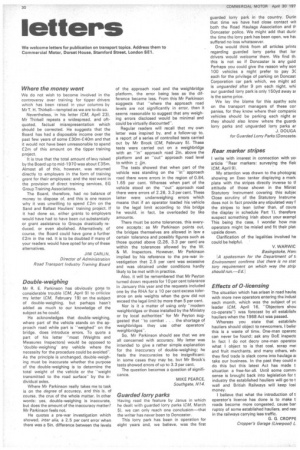Double-weighing
Page 32

If you've noticed an error in this article please click here to report it so we can fix it.
Mr R. E. Parkinson has obviously gone to considerable trouble (CM, April 91 to criticize my letter (CM, February 191 on the subject of double-weighing, but perhaps hasn't added as much to our knowledge of the subject as he could.
He acknowledges that double-weighing, where part of the vehicle stands on the approach road while part is "weighed" on the bridge, does introduce errors. To quote a part of his letter "most (Weights and Measures Inspectors) would be opposed to 'double-weighing' any vehicle where the necessity for the procedure could be avoided". As the principle is unchanged, double-weighing must be inaccurate whether the purpose of the double-weighing is to determine the total weight of the vehicle or the -weight transmitted to the road surface" by the individual axles.
Where Mr Parkinson really takes me to task is on the degree of accuracy, and this is, of course, the crux of the whole matter. In other words: yes, double-weighing is inaccurate, but does the amount of the inaccuracy matter? Mr Parkinson feels not.
He quotes a pre-war investigation which showed, inter alia, a 2.5 per cent error when there was a 5in, difference between the levels of the approach road and the weighbridge platform, the error being less as the difference became less. From this Mr Parkinson suggests that "where the approach road levels are not significantly in error, then it seems reasonable to suggest that any weighing errors disclosed would be minimal and could be virtually discounted".
Regular readers will recall that my own letter was inspired by, and a follow-up to, a report of a series of controlled tests carried out by Mr Brock (CM, February 5). These tests were carried out on a weighbridge with an "in" approach road 2in. above the platform and an "out" approach road level to within +
The tests showed that when part of the vehicle was standing on the "in" approach road there were errors in the region of 0.84. 1.65 per cent. Whereas when part of the vehicle stood on the "out" approach road there were errors of 2.26, 3.3 per cent. These latter were underweighing errors which means that if an operator loaded his vehicle to the legal limit according to this bridge he would, in fact, be overloaded by like amounts.
There must be some tolerances, this everyone accepts: as Mr Parkinson points out, the bridges themselves are allowed in law a certain tolerance and possibly figures such as those quoted above (2.26. 3.3 per cent) are within the tolerances allowed by the W. & M. Inspectors. However. Mr Parkinson implied by his reference to the pre-war investigation that 2.5 per cent was excessive and was obtained under conditions hardly likely to be met with in practice.
Also, it will be remembered that Mr Peyton turned down requests for 10 per cent tolerance in January this year and the requests included one by the R HA for a 10 per cent excess tolerance on axle weights when the gvw did not exceed the legal limit by more than 5 per cent.
Nor is it a matter of using only -modern weighbridges or those installed by the Ministry or by local authorities" for Mr Peyton suggested that "to combat . . the shortage of weighbridges they use other operators' weighbridges".
So. Mr Parkinson should see that we are all concerned with accuracy. My letter was intended to give a rather simple explanation for the inaccuracy of double-weighing: he feels the inaccuracies to be insignificant: in some cases they may be, but Mr Brock's tests showed errors of up to 3.3 per cent.
The question becomes a question of significance.
MIKE PEARCE, Southgate, N14.




























































































